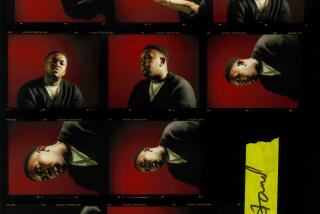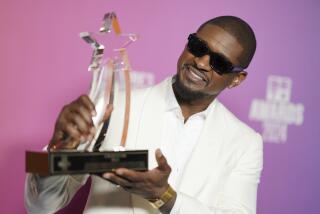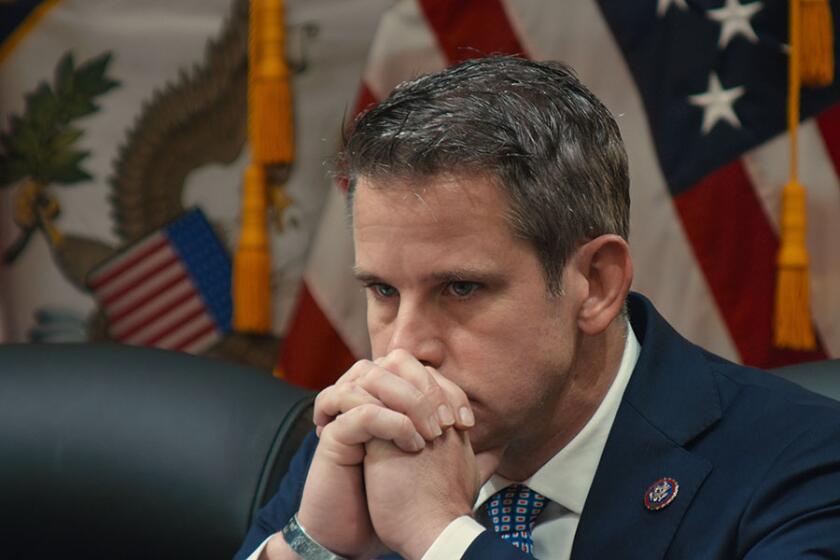Beyond Satchmo
In the last years of his remarkable five-decade career as one of the world’s most loved entertainers, Louis Armstrong was known to most of the general public as something of a caricature.
“Satchmo,” as he was universally called, was a grinning, amiable figure, singing in an instantly recognized gravelly voice and carrying a golden trumpet that he occasionally used to play a few hot licks. (The “Satchmo” label traces to a shortening of “Satchelmouth,” an appellation bestowed on him in his youth to describe his large mouth. Musicians morecommonly referred to him as “Pops.”)
It was a characterization that had been part of Armstrong’s persona since the early ‘30s, one facet of a complex musical personality. And it would give him worldwide fame, popping up over and over again in films and television, on recordings and concert stages.
Armstrong’s album of the music from “Hello, Dolly!” was so successful that it knocked “The Beatles’ Second Album” out of the No. 1 position on the pop charts in the spring of 1964, with Armstrong’s rendering of the title song also reaching No. 1. His other pop hits included “Mack the Knife,” “Blueberry Hill” and “What a Wonderful World” (when it was heard on the soundtrack of “Good Morning, Vietnam” in 1988, 17 years after Armstrong’s death).
He appeared in Vincente Minnelli’s first film, the highly stylized “Cabin in the Sky,” in 1943 with Lena Horne, as well as in “High Society,” the flat musical remake of “The Philadelphia Story,” in 1956. And he showed up for one chorus of the title number in the Barbra Streisand film version of “Hello, Dolly!” in 1969, undoubtedly because of his earlier hit recording.
For Armstrong, who died 25 years ago this Saturday, “Satchmo” was intrinsic to his belief that there was no separation between art and entertainment. But the characterization, for all its commercial successes, represents only one aspect of who he really was, and what his true legacy has been. The complete Armstrong, the Armstrong who looms over the Satchmo persona, was a trumpeter first and foremost. And the sound and the substance of that trumpet composed the first great clarion voice in jazz history.
Very simply, he was the father of jazz improvisation, the first (and for some the most) influential jazz trumpeter and, with Duke Ellington and Charlie Parker, one of the music’s trinity of great creators. In the 1920s, Armstrong formulated the essential elements of jazz--solos that soared above the basic harmonies of a song, a driving sense of instrument and a deep understanding of the blues.
And although the creative aspects of his work were less apparent in his Satchmo performances than in his astonishing, jazz-building efforts of the ‘20s and ‘30s, they nonetheless were always there, even in the performances in which he became a virtual caricature of himself.
“Louis Armstrong,” says Wynton Marsalis, a champion of Armstrong’s music from his position as artistic director of the Jazz at Lincoln Center program, “was the embodiment of jazz. And the thing you have to know about him is that whatever he played, it had the complete and total feeling of jazz in it.”
Marsalis’ point is precisely right. Armstrong’s capacity to integrate the communicative qualities of the Satchmo personality with his essential, unerring musical creativity is the key to understanding and appreciating the importance of his total contribution to jazz.
In the years since Armstrong’s death, jazz styles have come and gone, and there were times when Armstrong’s upbeat approach to music virtually disappeared, when it seemed as though his legacy might be buried in a high-decibel wash of electronics and funk rhythms.
But in the last decade, the dark, introverted jazz of the ‘60s and ‘70s--much of it strongly inspired by the inner-focused work of Miles Davis--has begun to give way to a music that looks toward a broader view of the Armstrong legacy.
“It’s his optimism,” Marsalis says. “Louis doesn’t have a whining type of thing in his music. It’s heroic and optimistic. You don’t hear that me-generation type of thing in his playing.”
Marsalis, like Armstrong, is a product of the constantly simmering musical melting pot of New Orleans, and he sees in Armstrong a typically Orleans-style combination of outer ebullience and inner intensity.
“Everything about Louis is New Orleans,” Marsalis explains. “His way of speaking, his easygoing manner. But also his fire, the range in his character and, especially, the way he could go from the profane to the sacred.”
And Marsalis can take a good share of the credit for the return of the outward-looking, upbeat but determinedly creative Armstrong-like approach to jazz that is heard in the Marsalis-influenced young jazz lions of the ‘90s.
As the most visible and influential jazz musician to emerge in the decades after Armstrong’s death, Marsalis has played a critical role in reviving interest in the legacy of the legendary trumpeter. His father, educator and pianist Ellis Marsalis, has also been an influence through his consistent advocacy of Armstrong’s importance to students such as emerging star trumpeters Nicholas Payton and Terence Blanchard.
Yet even Marsalis came to Armstrong’s music via a roundabout route that first had to move past the Satchmo image.
“I always knew about him, coming from New Orleans,” Marsalis recalls. “But it wasn’t until I moved to New York, when I was 18, that I became aware of him as a jazz musician.”
Younger players, even with Marsalis’ advocacy of Armstrong, had similar reactions.
“At first, I didn’t really take him seriously as a musician,” Payton says. “Then, when I was about 16 or 17, I started really listening to him. All the modern things that people do now, he was doing back in the ‘20s and ‘30s--playing in different meters, expanding the range of the trumpet. Nobody thought you could play above high C before Louis. There hasn’t been anyone like him since, in terms of the magnitude of his influence.”
The Armstrong-esque revival of a spirited, outgoing approach that was triggered by Marsalis--a kind of jazz of joy--is especially apparent in Payton’s work. In his recent appearance at the Jazz Bakery in Culver City, he rendered Armstrong’s “Wild Man Blues” with a collection of half-valve flares, glissandos, growls and soaring high notes that would have done Armstrong proud.
“Louis didn’t just make music for music’s sake,” Payton adds, “or to play just for the other musicians. He played to uplift people’s spirits. And I think music in general needs to be that way. Musicians tend to become self-important after a while and feel that everything revolves around them. But Louis knew that if the audience didn’t want to clap their hands or pat their feet, then something wasn’t happening.”
The elements of jazz are so much an accepted and familiar part of the soundtrack of20th century life that it’s difficult to imagine what it was like without them. Yet to an extraordinary degree, the creative development and the widespread distribution of those elements would not have happened without Armstrong.
“There’s nothing you can play on that horn,” Miles Davis once said, “that Louis didn’t play first.”
It’s a curious quote, coming from a trumpeter who took a left turn from Armstrong, pulling jazz with him into an interior dialogue that was worlds away from the outgoing Armstrong. Yet it indicates Armstrong’s eminence--even among musicians who chose dramatically different pathways.
And it wasn’t just trumpeters. In the early jazz decades, the playing of virtually every jazz instrumentalist was affected by Armstrong. Coleman Hawkins, for example, the first influential saxophonist, was clearly influenced in a powerful way by Armstrong’s music. And Armstrong’s soloing with the Fletcher Henderson orchestra offered an object lesson in the potential of instrumentalist-ensemble interaction to arrangers such as Henderson, Benny Carter and Don Redman.
The influence upon his musical contemporaries of the recordings Armstrong made in the late ‘20s with his Hot Fives was overwhelming: “Potato Head Blues” and “Cornet Chop Suey,” with their brilliant trumpet improvisations over stop-time rhythms; the soaring, vocalized solos on “West End Blues”; the harmonically complex soloing on “Weather Bird”; the cross-the-bar line rhythms of “Mahogany Hall Stomp.”
The techniques had all been toyed with in one form or another by other players, but never in such total, confident, style-establishing fashion as Armstrong’s. And never with the driving sense of swing--the feeling that each note is being lifted by its own internal rhythm--that was an Armstrong invention.
“The first time I tried to learn one of his solos,” Marsalis says, “was a moment of epiphany. The song was ‘Jubilee.’ I remember what it was, and because it sounded so simple, I said, ‘Let me learn that.’ But I couldn’t play it. Even now, I don’t think I can make it through it. He had such tremendous endurance.”
Add to the importance of Armstrong’s trumpet playing his singing, which was utterly original at the time, and as much reflective of his instrumental style as the instrumental style was an extension of his vocalized method of approaching a melody. Neither popular singing nor jazz singing was ever the same after Armstrong recorded his freely phrased, improvisational renderings of songs such as “Stardust,” “Ain’t Misbehavin’,” “I Can’t Give You Anything but Love” and “Between the Devil and the Deep Blue Sea,” to name only a few.
Bing Crosby’s easygoing style, so often seen as a reflection of his personality, was a direct extension of the emotional honesty with which Armstrong approached a lyric. And it’s hard to believe that the justifiably applauded phrasing of Billie Holiday (and Frank Sinatra as well) would ever have evolved the way it did without the prior example of Armstrong’s vocals. Nor would scat singing have become so popular so quickly without Armstrong’s genre-defining 1926 recording “Heebie Jeebies.” No one learned Armstrong’s lessons--in phrasing and scat singing--any better than Ella Fitzgerald, and their recordings together are among the great classics of jazz.
Other trumpeters preceded Armstrong, of course. Most notably, the legendary (he apparently was never recorded) Buddy Bolden, Freddie Keppard and Bunk Johnson. But Armstrong, who wasborn Aug. 4, 1901, never heard Bolden, who was confined to a mental institution in 1907 and remained there until his death in 1931.
Armstrong’s first contact with a brass instrument--the cornet, initially--didn’t take place until he too was confined to an institution, the New Orleans Home for Colored Waifs, after an encounter with the police as a teenager. It turned out to be an unexpectedly fortunate sentence, since it was here that his talent first began to surface. By 1918, he was working with Kid Ory’s band, and in 1922 he took his first major step to fame when he joined King Oliver’s Creole Jazz Band as second cornetist.
A move to New York in 1924 to play with Henderson was followed by a period in Chicago in the latter part of the decade in which Armstrong produced most of his celebrated recordings with his Hot Five ensemble and its successor, the Hot Seven. The performances--recorded with Johnny Dodds, clarinet; Kid Ory, trombone; Johnny St. Cyr, banjo; and Lil Hardin Armstrong (the second of his four wives), piano--had a extraordinarily transformative effect upon the jazz of the period.
Then, in the ‘30s, Armstrong--like so many other outstanding instrumentalists--tried his hand at leading a variety of big bands.
“Some of the stuff he did with the big bands is a little corny,” Marsalis says, “but what he’s playing is great. The problem of Armstrong with a big band was that he was too great a soloist. A big band means everybody else is playing too. And that’s not what people wanted to hear; they wanted to hear Louis Armstrong play.”
From the ‘30s on, Armstrong was as much a popular entertainer as he was a jazz musician--a fact that rankled some jazz fans. But Armstrong himself, in his own way, simply pointed out that there was entertainment in art and art in entertainment. From about 1947 until his death, he led New Orleans-style ensembles, initially in all-star formats that included players such as Jack Teagarden, Trummy Young, Edmond Hall and Barney Bigard.
“His responsibility to the world at that time,” Marsalis says, “was different from what it was when he was 20 or 30. In the ‘50s and ‘60s, his job was to bring the music around the world. That’s why he was known as ‘Ambassador Satch.’ He was the most popular musician in the world at that time. And everybody loved him because of the soul that was coming from him.”
Marsalis may be overstating the case somewhat. There was a period in the ‘50s when Armstrong was viewed by some liberals as a kind of musical Uncle Tom, pushing American values at a time when African Americans in the South were experiencing the dangerous days of desegregation.
But the epithet bore no relationship to the real Armstrong. (“Pops,” Billie Holiday once said sardonically, “toms from the heart.”)
“Whenever he was called an Uncle Tom,” says Dan Morgenstern, director of the Institute of Jazz at Rutgers University and an Armstrong historian, “his only response was just to shrug it off.”
On at least two widely reported instances, Armstrong brusquely set aside the Satchmo persona to speak out about events taking place in the South in the ’50 and ‘60s.
“At the time of the school standoff in Little Rock in 1957,” Morgenstern recalls, “he was watching television, with people throwing rocks and stuff. And he told an AP writer that Eisenhower had no guts, that if it was him, he would go down there and personally walk those kids into the school. The story raised all kinds of commotion, with Sammy Davis Jr. saying that Louis had no right to speak for black people.”
Despite pressure from his management, Armstrong refused to withdraw his statement. And in 1965, when he read of the riots in Selma, Ala., he went public again, saying, “They would beat Jesus if he was black and marched.”
In his last years, Armstrong’s physical problems--he had a heart attack in 1959, was plagued by kidney problems and ulcers throughout the ‘60s and endured a tracheotomy in 1969--reduced the frequency and the effectiveness of his trumpet playing. But his upbeat, optimistic attitude stayed with him until the end.
“If I can’t play the horn,” he told Morgenstern, “I can always sing.”
And, as Marsalis has pointed out, even in Armstrong’s singing, even in his Satchmo persona, the great creative strengths were always present. His creative legacy--an approach to music that is open, honest, outgoing and upbeat--is back again, and it looks as though it will play an important role in jazz for a long time to come.
“Look,” Marsalis says, “here’s a man who grew up with real tragedy all around him, and he never succumbed to it. He never allowed his problems to overwhelm him. He never fell prey to that theme of the 20th century--self-absorbed, angst-ridden tragedy. You get a Hemingway or a Faulkner or a Schoenberg, and there’s an air of tragedy lingering around everything.
“But with Louis Armstrong,” he says, “you don’t get that. You get optimism. That’s his most important contribution. Because you can only go in one direction with depression--down. The only real solution is to find something that will address your problems and still keep you going up. And Louis Armstrong understood how to do that.”
More to Read
Only good movies
Get the Indie Focus newsletter, Mark Olsen's weekly guide to the world of cinema.
You may occasionally receive promotional content from the Los Angeles Times.










